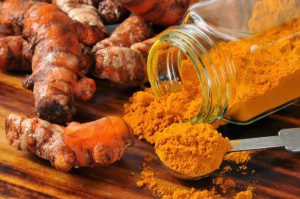Guest Writer for Wake Up World
Turmeric, or Curcuma longa, is an ancient spice used traditionally among the peoples of India and Asia as far back as 2,000 BC. The spice belongs in the ginger family and has been highly prized in the culinary traditions of these ancient cultures for millennia. Turmeric imparts a vibrant yellowish hue to curry dishes, and the spice is also used as a natural dyeing agent for cloths. In Persia, turmeric comes from the word saffron and is closely related to the spice.
The main phytochemicals that give turmeric its most impressive and wide-ranging health benefits are curcuminoids. Amazingly, over 9,000 medical and clinical research studies have been conducted on this amazing spice and its extracted curcumin in recent years, with most finding significant physiological benefits.
[pro_ad_display_adzone id=”110028″]
There are 3 primary phytochemicals in the curcuminoid family credited for its health benefits: diferuloylmethane (or curcumin, the primary curcuminoid responsible for turmeric’s vibrant yellowish color), demethoxycurcumin, and bisdemethoxycurcumin. In addition to these three chemicals, turmerone is another of the potent volatile oils found in the root.
Research has proven these curcuminoids exert powerful health-promoting effects via 160 mechanisms and pathways in the body such as antioxidant, neuroprotective, immunomodulatory, anti-inflammatory, epigenetic, and adaptogenic properties.[1] [2]
8 Health Benefits of Turmeric
Turmeric provides an abundance of antioxidants capable of supporting cellular health, but what does that mean for you? Here are some of the most well-researched benefits of turmeric.
1. Mood Balancing
A randomized, double-blind, placebo-controlled study in the Journal of Affective Disorders showed noticeable and promising results with turmeric for symptoms of depression. Two groups were studied over 8 weeks. The first group received curcumin (the main therapeutic constituent in turmeric) daily, while the other received placebo. After 8 weeks, the depression and anxiety score tests completed by all of the participants showed significant symptom improvements compared to placebo. Could turmeric be a potential new option in your cabinet for stabilizing mood? [3] Only future and more in-depth research can determine for sure.
2. Wound Healing
Cut your finger? A study in the Sept 2014 issue of Life Sciences found that turmeric (curcumin) has beneficial properties that appear to speed the wound healing process. These modes of action include the modulation of redness and welling and oxidation. As new studies come to light showing turmeric’s ability to potentiate the body’s natural healing processes and outcome, the possible breadth of applications could be enormous. [4]
An exciting study in the Oct 2006 issue of Molecular and Cellular Biochemistry demonstrated the efficacy of a topical turmeric application for wounds in rats. The results showed that turmeric increased collagen synthesis rates, improved wound contraction, and increased tissue strength and cell proliferation around the wound. Turmeric also showed antioxidant properties that helped the healing process[5]
3. Pain Relief
An impressive multicenter study completed and published in the March 2014 issue of the Journal of Clinical Interventions in Aging looked at the effect of turmeric on knee osteoarthritis pain and function. Two groups were randomized and divided; one group received turmeric extract, while the other group received the daily UL (upper limit) dose of the NSAID pain-reliever ibuprofen. The study was conducted for 4 weeks and thorough questionnaires were given pre- and post-study completion to assess effectiveness.
Results showed that the turmeric group experienced pain relief to an equal extent as the ibuprofen group. The turmeric group, however, seemed to enjoy more relief from joint stiffness compared with the participants taking ibuprofen. Those taking turmeric reported significantly less side effects than those taking NSAIDs. [6] A double-blind, placebo-controlled study in the December 2011 issue of Surgical Endoscopy looked at turmeric supplementation on postoperative pain and fatigue in patients who had gallbladder surgery. Patients taking turmeric experienced significantly less pain and fatigue (per pain scale log assessments) at intervals of 3 weeks, as compared to placebo. [7]
[pro_ad_display_adzone id=”110030″]
4. Blood Sugar Optimization
A novel investigative study published in the Nov 2014 issue of The Journal of Endocrinology looked at the effects of turmeric (curcumin, specifically) on the insulin-producing cells of the pancreas called Beta cells (or B-cells) and Islet cells, in relation to type-2 diabetes conditions. Researchers treated B-cell lines and human Islet cells with preparations of turmeric and found impressive insulin secretion improvements, improved insulin sensitivity, and a reduction of PDEs, enzymes that are deleterious to health and function in the pancreas. [8] This study, among others, suggest that curcumin may aid future approaches to type-2 diabetes.
5. Soothing Properties
Turmeric has been shown in studies to be valuable in helping the body modulate and buffer excess inflammation. The inflammatory response is a healthy and natural mechanism the body uses to usher soothing compounds in acute times of crises or repair. It’s believed that most people in today’s toxic, stress-laden environment are under constant inflammatory conditions, and a growing number of individuals in the health community now believe this to be the origin of many disease processes.
A review study published in the 2007 issue of Advances of Experimental Medicine reviewed studies looking at the mechanisms of turmeric to come to an understanding of how it likely works. Researchers discovered the anti-inflammatory effect of turmeric (curcumin) is likely exerted through its ability to inhibit inflammatory enzymes including cyclooxygenase-2 (COX-2), lipoxygenase (LOX), and nitric oxide synthase (NOS), among others. These three are particularly important enzymes that mediate and inform the inflammatory processes, though if poorly regulated can possibly lead to disease. Turmeric shows promise in helping the body adapt and regulate these enzymes. [9] [10]
6. Arthritis Relief
A randomized, pilot clinical study was published in the November 2012 issue of Phytotherapy Research. The goal of the study was to see the effectiveness and/or difference in the relief of active arthritis pain in treatment groups. One study group received the standard-of-care medication (diclofenac sodium), while the other received turmeric. Patients were given symptom score sheets (DAS/ACR) to assess results. Turmeric outperformed diclofenac sodium on all levels, including being relatively free from adverse side effects. [11]
7. Cholesterol Optimization
Turmeric’s ability to help the body regulate and balance cholesterol levels has been hypothesized and studied since the 1990s with varying levels of benefits. A couple of these studies show an impressive reduction in lipid profiles and cholesterol markers in turmeric-supplemented groups. One randomized, single-blind clinical study published in the November 2011 issue of Phytotherapy Research set out to investigate turmeric’s effect on cholesterol and triglyceride levels.
Group participants were given either turmeric (curcumin) in low or high doses, and a control group was given vitamin E only. After just seven days, the results proved statistically significant. Low-dose turmeric showed the most improvement as compared to the other two groups, with serum cholesterol levels being reduced by 17% and triglycerides being slashed a whopping 47%! [12]
Another study conducted a similar seven day trial. Results showed the turmeric (curcumin) supplemented participants had reduced serum cholesterol by 12%, reduced lipid peroxides (cholesterol byproduct marker) by 33%, and increased HDL cholesterol (the good kind) by an impressive 29%. Most importantly, these studies show that turmeric is consistently safe and has very low risk of side effect. [13]
8. Gastroprotective (Ulcers)
India has long used turmeric in curry dishes as a taste and color enhancer. Another key reason turmeric has been used in so many cultural dishes in the East for millennia is because of its soothing properties on digestion. Researchers wanted to test the protective effects of turmeric on the lining of the stomach against acidic preparations (ethanol) used to induce stomach ulcers in test animals (representative of humans).
A preparation containing the essential oils from turmeric was administered prior to the ethanol and the results were impressive. Turmeric inhibited stomach ulcer formation by an impressive 85%. Lesions, tissue necrosis, and hemorrhaging were also greatly reduced. In addition, turmeric also appears to offer some impressive protection for stomach ailments.[14]
Some information out there suggests turmeric has hundreds of therapeutic and beneficial health properties, and as science advances and further studies are conducted on this amazing spice, the applications seem extremely exciting.
-Dr. Edward F. Group III, DC, ND, DACBN, DCBCN, DABFM
Article References:
- Sahdeo Prasad and Bharat B. Aggarwal. Herbal Medicine: Biomolecular and Clinical Aspects. Turmeric, the Golden Spice From Traditional Medicine to Modern Medicine. 2nd edition. Ch 13.
- Zhou H, Beevers CS, Huang S. The targets of curcumin. Curr Drug Target. 2011 Mar 1;12(3):332-47.
- Lopresti AL, Maes M. Curcumin for the treatment of major depression: a randomised, double-blind, placebo controlled study. J Affect Disord. 2014 Oct;167:368-75. doi: 10.1016/j.jad.2014.06.001.
- Akbik D, Ghadiri M, et al. Curcumin as a wound healing agent. Life Sci. 2014 Sep 6. pii: S0024-3205(14)00703-6. doi: 10.1016/j.lfs.2014.08.016.
- Panchatcharam M, Miriyala S. Curcumin improves wound healing by modulating collagen and decreasing reactive oxygen species. Mol Cell Biochem. 2006 Oct;290(1-2):87-96.
- Kuptniratsaikul V, Dajpratham P. Efficacy and safety of Curcuma domestica extracts compared with ibuprofen in patients with knee osteoarthritis: a multicenter study. Clin Interv Aging. 2014 Mar 20;9:451-8. doi: 10.2147/CIA.S58535.
- Agarwal KA et al. Efficacy of turmeric (curcumin) in pain and postoperative fatigue after laparoscopic cholecystectomy: a double-blind, randomized, placebo-controlled study. 2011 Dec; 25(12):3805–10.
- Rouse M, Younà¨s A. Resveratrol and curcumin enhance pancreatic β-cell function by inhibiting phosphodiesterase activity. J Endocrinol. 2014 Nov;223(2):107-17. doi: 10.1530/JOE-14-0335.
- Menon VP, Sudheer AR. Antioxidant and anti-inflammatory properties of curcumin. Adv Exp Med Biol. 2007;595:105-25.
- Chainani-Wu N. Safety and anti-inflammatory activity of curcumin: a component of tumeric. J Altern Complement Med. 2003 Feb;9(1):161-8.
- Chandran B1, Goel A. A randomized, pilot study to assess the efficacy and safety of curcumin in patients with active rheumatoid arthritis. Phytother Res. 2012 Nov;26(11):1719-25. doi: 10.1002/ptr.4639.
- Pungcharoenkul K, Thongnopnua P. Effect of different curcuminoid supplement dosages on total in vivo antioxidant capacity and cholesterol levels of healthy human subjects. Phytotherapy Research 2011 Nov; 25(11):1721–26.
- Soni KB, Kuttan R. Effect of oral curcumin administration on serum peroxides and cholesterol levels in human volunteers. Indian J Physiol Pharmacol. 1992 Oct;36(4):273-5.
- Liju VB, Jeena K. Gastroprotective activity of essential oils from turmeric and ginger. J Basic Clin Physiol Pharmacol. 2014 Apr 21.
Previous articles by Dr. Group:
- 7 Herbs for Men’s Health
- 6 Things You Must Know About Colloidal Silver
- The 9 Best Herbs for Lung Cleansing and Respiratory Support
- 7 Best Foods to Support Kidney Function
- How to Flush the Liver
- Lung Cleansing With Peppermint Oil
- The 5 Most Common Thyroid Disorders and What You Need To Know
- Nine Shocking Dangers of Fluoride Exposure
- Seven Facts You May Not Know About Coconut Oil
- 5 Dangerous Chemicals in Conventional Sunscreens
- How Colloidal Silver Combats Harmful Organisms
About the author:
 Dr. Edward F. Group III (DC, ND, DACBN, DCBCN, DABFM) founded Global Healing Center in 1998 and is currently the Chief Executive Officer. Heading up the research and development team, Dr. Group assumes a hands-on approach in producing new and advanced degenerative disease products and information.
Dr. Edward F. Group III (DC, ND, DACBN, DCBCN, DABFM) founded Global Healing Center in 1998 and is currently the Chief Executive Officer. Heading up the research and development team, Dr. Group assumes a hands-on approach in producing new and advanced degenerative disease products and information.
Dr. Group has studied natural healing methods for over 20 years and now teaches individuals and practitioners all around the world. He no longer sees patients but solely concentrates on spreading the word of health and wellness to the global community. Under his leadership, Global Healing Center, Inc. has earned recognition as one of the largest alternative, natural and organic health resources on the internet.
For more information, please visit Global Healing Center.
[pro_ad_display_adzone id=”110027″]







